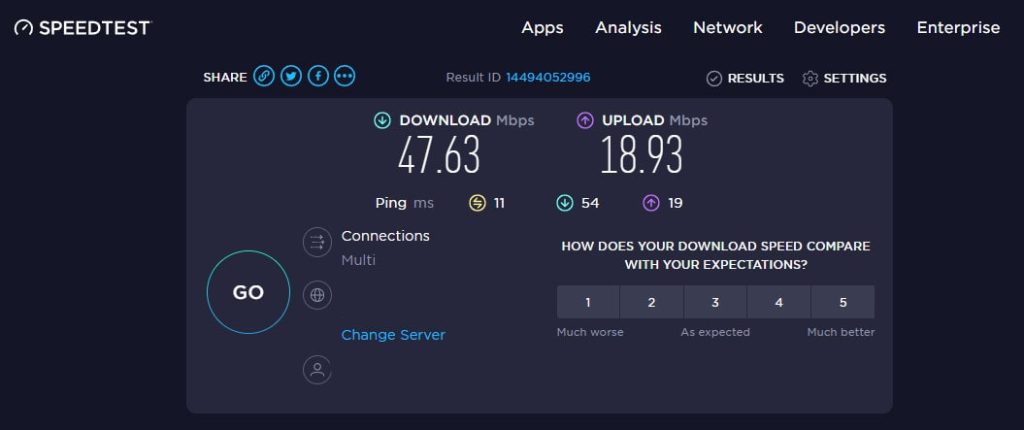If you’re considering switching internet service provider, you might be wondering what’s the best way to decide which provider and package to choose.
In this guide, we’ve explained what you need to consider when choosing a new internet provider, and how to find the right broadband plan for you and your family.
Let’s get started.
Step #1: Find out what providers are available where you live

When choosing a new broadband provider, the first thing to consider is which providers are available in your area.
Depending on where you live in Europe, different fibre broadband and ADSL/VDSL networks may be available at your address. And for each network that’s available, there may be more than one provider you can choose from.
For example, in Italy, Telecom Italia has the biggest broadband network, which is used by Tiscali and Wind Tre. However, there is also the Open Fiber network, which is used by other providers such as Sky Italia, and offers fibre-to-the-home connectivity, with speeds of up to 1 Gbps.
To find out which networks and providers are available at your address, you can often use a government website. Simply put in your postcode, and the available broadband networks will be shown.
For example, in Germany, you can use this Federal Network Agency (Bundesnetzagentur) webpage to see which broadband providers are available where you live: https://www.breitbandmessung.de/karte
If there is no government website that shows this information in your country, as is the case in Italy, you will have to go to each major network or provider’s website and use their coverage checker.
It’s important to avoid using comparison sites to find out which internet service providers you can choose from, because they will only display providers they have a commercial relationship with.
While comparison sites can give you an idea of some of the providers available, it’s important to do further research to ensure that you’re aware of all of the available options.
Step #2: Assess each provider’s customer support
Once you have an idea of which broadband providers service your address, you can begin to exclude providers you wouldn’t consider, based on factors such as their customer support.
To assess each broadband provider’s customer service, you might like to use review websites like Trustpilot, or ask friends and family how their experience has been with their internet service provider.
There are also consumer organisations that assess broadband providers’ customer service, such as Consumentenbond in the Netherlands.
In some countries, telecommunications regulators publish reports on the customer service performance of different broadband providers, such as how often customers complain, as well as customer satisfaction ratings.
For example, ComReg in Ireland does this, as well as the Swedish Post and Telecom Authority. These reports can provide a valuable objective measure of how satisfied each broadband provider’s customers are, making it easier to assess how good their customer service is.
Step #3: Consider what internet speed you need

The next step is to think about how much bandwidth you need, given how many people live at home, and how you use the internet.
In some countries, certain providers don’t offer ultrafast broadband packages. If you need fast speeds, you can exclude these providers. But if you don’t need fast fibre internet, you might like to focus on the cheaper providers instead.
In general, for a small household of 1-2 people, a 40-50 megabit download speed should be plenty. For a 2-4 person household, you might want a download speed of 75-100 or more megabits per second.
Remember, if your internet is too slow, you’ll experience buffering when watching videos, and lag when gaming, especially when other people get online. But if you have more speed than you need, you might be wasting a significant amount of money each month.
Having fast fibre internet is useful if you often download or upload large amounts of data, but is not a necessity for most households. Of course, if you don’t mind paying more for the luxury of gigabit internet, this is perfectly fine to do.
Step #4: Find out what broadband plans are available
Once you have an idea of which broadband providers you might consider, and what internet speed you need, you can compare their specific packages to find the best one for your specific needs.
When comparing different internet service providers, consider factors such as:
- Their upfront costs.
- Their monthly costs.
- Download and upload speeds (look for plans that offer a similar download speed to what you need).
- How speeds are advertised. Will you get a minimum download speed, or just an average?
- Contract lengths.
- The Wi-Fi router. Is your router included for free, and is it any good? How many Ethernet ports does it have? Does it support the latest Wi-Fi standards (currently Wi-Fi 6E)?
- Any other add-ons available, if these are of interest to you, such as landline calling minutes or cable TV.
- Any usage limits.
Step #5: See if you are entitled to a social tariff

In some countries, you may be entitled to a “social tariff”, which is a cheaper broadband plan for pensioners, the disabled, and/or those on low incomes or government support payments.
If you fall into one of these categories, it’s worth checking to see if social tariffs exist in your country. Currently, these cheaper plans are available in France, Spain, Italy, Germany, as well as some other European nations.
In each country, it’s only certain providers that offer social tariffs. You will need to apply for a discounted plan with the provider, and prove your eligibility, to get a cheaper price.
Step #6: Research how you’ll switch provider
Before committing to buy a certain broadband plan, depending on the country you live in, you might want to look into what is involved in changing from your current provider, to ensure that the switchover goes smoothly.
For example, you may want to consider:
- Are you still in contract with your current broadband provider? If so, are there any exit fees you will have to pay?
- Will you need to send back your current Wi-Fi router, if your provider supplied it?
- Will you need to contact your old provider to cancel the connection, or will the new company handle this for you? In most European countries, you can simply buy a new broadband plan, and the new provider will handle the cancellation for you.
- Will the two connections overlap, or will there be any downtime?
You may find that some broadband providers are more complex to switch to. For example, if you’re upgrading to fibre internet, the new provider may need to send an engineer to your address to get you online.
This might mean that switching will take longer, and you’ll need to ensure you’re at home when the engineer comes to visit.
Step #7: Switch provider

If you’ve decided on an internet provider and package, you’re now ready to make the switch!
Most of the time, all you need to do is place your order online, and wait for your new Wi-Fi router to arrive in the mail. Then, follow the instructions from your provider, and you’ll be able to get online.
If you have any questions about how to choose a broadband provider, feel free to leave them in the comments below, and we’ll respond as soon as we can.

I’m Roger, and I’m the founder of Broadband 4 Europe.
I grew up in Switzerland but live in Germany now, and also lived in South Tirol for a while in the past.
I have a background in IT and have performed extensive research into the broadband markets of most major European countries. Learning about fixed-line broadband markets is my nerdy hobby, but I’m also excited by the possibilities that 5G (and eventually 6G) broadband will provide us in the future.
When I’m not researching broadband companies and their networks, you’ll find me playing volleyball or the piano.





